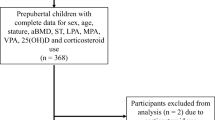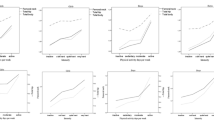Abstract
Summary
In a free-living cohort of 4-year old children, mean daily time in moderate–vigorous physical activity and daily calcium intake at 3 years, were positively related to hip bone size and density. Relationships between physical activity and bone indices were stronger when calcium intake was above compared with below median (966 mg/day).
Introduction
We examined the cross-sectional relationships between childhood physical activity, dietary calcium intake and bone size and density.
Methods
Children aged 4 years were recruited from the Southampton Women's Survey. They underwent measurement of bone mass by DXA (Hologic Discovery). Physical activity was assessed by accelerometry (Actiheart, Cambridge Neurotechnology Ltd, Cambridge, UK) for seven continuous days.
Results
Four hundred twenty-two children (212 boys) participated. In a cross-sectional analysis, after adjusting for gender, daily mean time(minutes per day) spent in moderate to very vigorous activity (MVPA) was positively related to hip BA (R 2 = 3%, p < 0.001), BMC (R 2 = 4%, p < 0.001), aBMD (R 2 = 3%, p = 0.001) and estimated vBMD (R 2 = 2%, p = 0.01), but not height (r s = 0.04, p = 0.42) or weight (r s = 0.01, p = 0.76). Mean daily calcium intake (assessed at 3 years old) positively predicted bone indices in those with a calcium intake below the median (966 mg/day), but there was a much attenuated relationship in those above this. These associations persisted after inclusion of total energy, protein and phosphorus in multivariate models. The relationships between MVPA and bone indices were stronger in children with calcium intakes above the median. Thus, for aBMD, the variance explained by MVPA when daily calcium intake was below the median was 2% (p = 0.1) and above median was 6% (p = 0.001).
Conclusions
These results support the notion that adequate calcium intake may be required for optimal action of physical activity on bone development and that improving levels of physical activity and calcium intake in childhood may help to optimise accrual of bone mass.


Similar content being viewed by others
References
Jackson-Leach R, Lobstein T (2006) Estimated burden of paediatric obesity and co-morbidities in Europe. Part 1. The increase in the prevalence of child obesity in Europe is itself increasing. Int J Pediatr Obes 1:26–32
Li S, Treuth MS, Wang Y (2010) How active are American adolescents and have they become less active? Obes Rev 11:847–862
Samdal O et al (2007) Trends in vigorous physical activity and TV watching of adolescents from 1986 to 2002 in seven European Countries. Eur J Public Health 17:242–248
Goulding A, Jones IE, Taylor RW, Williams SM, Manning PJ (2001) Bone mineral density and body composition in boys with distal forearm fractures: a dual-energy x-ray absorptiometry study. J Pediatr 139:509–515
Godfrey K et al (2001) Neonatal bone mass: influence of parental birthweight, maternal smoking, body composition, and activity during pregnancy. J Bone Miner Res 16:1694–1703
Javaid MK et al (2006) Maternal vitamin D status during pregnancy and childhood bone mass at age 9 years: a longitudinal study. Lancet 367:36–43
Cooper C et al (1995) Childhood growth, physical activity, and peak bone mass in women. J Bone Miner Res 10:940–947
Hernandez CJ, Beaupre GS, Carter DR (2003) A theoretical analysis of the relative influences of peak BMD, age-related bone loss and menopause on the development of osteoporosis. Osteoporos Int 14:843–847
Janz KF et al (2001) Physical activity and bone measures in young children: the Iowa bone development study. Pediatrics 107:1387–1393
Morris FL, Naughton GA, Gibbs JL, Carlson JS, Wark JD (1997) Prospective ten-month exercise intervention in premenarcheal girls: positive effects on bone and lean mass. J Bone Miner Res 12:1453–1462
Bradney M et al (1998) Moderate exercise during growth in prepubertal boys: changes in bone mass, size, volumetric density, and bone strength: a controlled prospective study. J Bone Miner Res 13:1814–1821
Clark EM, Ness AR, Tobias JH (2008) Vigorous physical activity increases fracture risk in children irrespective of bone mass: a prospective study of the independent risk factors for fractures in healthy children. J Bone Miner Res 23:1012–1022
Winzenberg T, Shaw K, Fryer J, Jones G (2006) Effects of calcium supplementation on bone density in healthy children: meta-analysis of randomised controlled trials. BMJ 333:775
Huncharek M, Muscat J, Kupelnick B (2008) Impact of dairy products and dietary calcium on bone-mineral content in children: results of a meta-analysis. Bone 43:312–321
Specker BL (1996) Evidence for an interaction between calcium intake and physical activity on changes in bone mineral density. J Bone Miner Res 11:1539–1544
Specker BL, Mulligan L, Ho M (1999) Longitudinal study of calcium intake, physical activity, and bone mineral content in infants 6–18 months of age. J Bone Miner Res 14:569–576
Inskip HM et al (2006) Cohort profile: the Southampton Women's Survey. Int J Epidemiol 35:42–48
Corder K et al (2007) Comparison of two methods to assess PAEE during six activities in children. Med Sci Sports Exerc 39:2180–2188
Corder K, Brage S, Wareham NJ, Ekelund U (2005) Comparison of PAEE from combined and separate heart rate and movement models in children. Med Sci Sports Exerc 37:1761–1767
Brage S, Brage N, Franks PW, Ekelund U, Wareham NJ (2005) Reliability and validity of the combined heart rate and movement sensor Actiheart. Eur J Clin Nutr 59:561–570
Abrams SA et al (1988) Bone mineral content reflects total body calcium in neonatal miniature piglets. Pediatr Res 24:693–695
Brunton JA, Weiler HA, Atkinson SA (1997) Improvement in the accuracy of dual energy x-ray absorptiometry for whole body and regional analysis of body composition: validation using piglets and methodologic considerations in infants. Pediatr Res 41:590–596
Bass S et al (1998) Exercise before puberty may confer residual benefits in bone density in adulthood: studies in active prepubertal and retired female gymnasts. J Bone Miner Res 13:500–507
Karlsson MK, Johnell O, Obrant KJ (1995) Is bone mineral density advantage maintained long-term in previous weight lifters? Calcif Tissue Int 57:325–328
Kannus P et al (1995) Effect of starting age of physical activity on bone mass in the dominant arm of tennis and squash players. Ann Intern Med 123:27–31
Janz KF et al (2004) Everyday activity predicts bone geometry in children: the Iowa bone development study. Med Sci Sports Exerc 36:1124–1131
Du XQ et al (2002) Milk consumption and bone mineral content in Chinese adolescent girls. Bone 30:521–528
Rozen GS et al (2001) Calcium intake and bone mass development among Israeli adolescent girls. J Am Coll Nutr 20:219–224
Black RE, Williams SM, Jones IE, Goulding A (2002) Children who avoid drinking cow milk have low dietary calcium intakes and poor bone health. Am J Clin Nutr 76:675–680
Goulding A et al (2004) Children who avoid drinking cow's milk are at increased risk for prepubertal bone fractures. J Am Diet Assoc 104:250–253
Barr SI, Petit MA, Vigna YM, Prior JC (2001) Eating attitudes and habitual calcium intake in peripubertal girls are associated with initial bone mineral content and its change over 2 years. J Bone Miner Res 16:940–947
Bonjour JP et al (1997) Calcium-enriched foods and bone mass growth in prepubertal girls: a randomized, double-blind, placebo-controlled trial. J Clin Invest 99:1287–1294
Bonjour JP, Chevalley T, Ammann P, Slosman D, Rizzoli R (2001) Gain in bone mineral mass in prepubertal girls 3.5 years after discontinuation of calcium supplementation: a follow-up study. Lancet 358:1208–1212
Specker B, Binkley T (2003) Randomized trial of physical activity and calcium supplementation on bone mineral content in 3- to 5-year-old children. J Bone Miner Res 18:885–892
Macdonald HM et al (2008) Does a novel school-based physical activity model benefit femoral neck bone strength in pre- and early pubertal children? Osteoporos Int 19:1445–1456
Macdonald HM, Kontulainen SA, Khan KM, McKay HA (2007) Is a school-based physical activity intervention effective for increasing tibial bone strength in boys and girls? J Bone Miner Res 22:434–446
Havill LM, Mahaney MC, Binkley L, Specker BL (2007) Effects of genes, sex, age, and activity on BMC, bone size, and areal and volumetric BMD. J Bone Miner Res 22:737–746
Sundberg M et al (2001) Peripubertal moderate exercise increases bone mass in boys but not in girls: a population-based intervention study. Osteoporos Int 12:230–238
Bailey DA, McKay HA, Mirwald RL, Crocker PR, Faulkner RA (1999) A six-year longitudinal study of the relationship of physical activity to bone mineral accrual in growing children: the university of Saskatchewan bone mineral accrual study. J Bone Miner Res 14:1672–1679
Jones G, Dwyer T (1998) Bone mass in prepubertal children: gender differences and the role of physical activity and sunlight exposure. J Clin Endocrinol Metab 83:4274–4279
Dimitri P, Wales JK, Bishop N (2010) Fat and bone in children: differential effects of obesity on bone size and mass according to fracture history. J Bone Miner Res 25:527–536
Goulding A (2007) Risk factors for fractures in normally active children and adolescents. Med Sport Sci 51:102–120
Goulding A, Jones IE, Taylor RW, Manning PJ, Williams SM (2000) More broken bones: a 4-year double cohort study of young girls with and without distal forearm fractures. J Bone Miner Res 15:2011–2018
Manias K, McCabe D, Bishop N (2006) Fractures and recurrent fractures in children; varying effects of environmental factors as well as bone size and mass. Bone 39:652–657
Clark EM, Tobias JH, Ness AR (2006) Association between bone density and fractures in children: a systematic review and meta-analysis. Pediatrics 117:e291–e297
Goulding A et al (2000) Overweight and obese children have low bone mass and area for their weight. Int J Obes Relat Metab Disord 24:627–632
Whiting SJ (2002) Obesity is not protective for bones in childhood and adolescence. Nutr Rev 60:27–30
Marshall D, Johnell O, Wedel H (1996) Meta-analysis of how well measures of bone mineral density predict occurrence of osteoporotic fractures. BMJ 312:1254–1259
Acknowledgements
We thank the mothers who gave us their time and a team of dedicated research nurses and ancillary staff for their assistance. This work was supported by grants from the Medical Research Council, British Heart Foundation, Arthritis Research UK, National Osteoporosis Society, International Osteoporosis Foundation, Cohen Trust, NIHR Nutrition Biomedical Research Unit, University of Southampton, and NIHR Musculoskeletal Biomedical Research Unit, University of Oxford. Participants were drawn from a cohort study funded by the Medical Research Council and the Dunhill Medical Trust. We thank Mrs. G. Strange and Mrs. L. Reeves for helping prepare the manuscript.
Conflicts of interest
None.
Funding sources
Medical Research Council; Arthritis Research UK; National Osteoporosis Society; Wellbeing; Cohen Trust; NE (now North) Thames NHS R&D Directorate.
Author information
Authors and Affiliations
Consortia
Corresponding author
Additional information
SWS Study Group: P. Taylor, M. Hanson, D. J. P. Barker, C. M. Law
Rights and permissions
About this article
Cite this article
Harvey, N.C., Cole, Z.A., Crozier, S.R. et al. Physical activity, calcium intake and childhood bone mineral: a population-based cross-sectional study. Osteoporos Int 23, 121–130 (2012). https://doi.org/10.1007/s00198-011-1641-y
Received:
Accepted:
Published:
Issue Date:
DOI: https://doi.org/10.1007/s00198-011-1641-y




